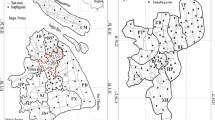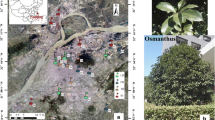Abstract
In this study, samples of dustfall collected monthly or semi-monthly, during 1997–1999, at two representative sites (Kexueguan: KLD and Gaolanxan: GLX) in Lanzhou, a typical industrial city in northwestern China, have been examined using environmental magnetic measurements. A set of magnetic parameters of 50 dustfall samples were analysed. Results demonstrate that Lanzhou City is heavily polluted, with the main pollution sources being anthropogenic activities and natural dust. The former poses a threat to human health all the year, which is different from the general opinion that natural dust is the main source of pollution in summer. This study extended the application of environmental magnetic techniques and can be regarded as a progressive step in exploring urban pollution problems using environmental magnetic techniques. The results from the present study have an important implication on the design of future urban pollution control strategies in Lanzhou, and the method could be applied to other urban cities in the world.





Similar content being viewed by others
References
Adgate JL, Willis RD, Buckley TJ, Chow JC, Watson JG, Rhoads GG, Lioy PJ (1998) Chemical mass balance source apportionment of lead in house dust. Environ Sci Technol 32:108–114
An J, Zhang R, Han Z (2000) Seasonal changes of total suspended particles in the air of 15 big cities in northern parts of China. Clim Environ Res 5(1):25–29
Chen FH, Zhang WX (1993) Loess stratigraphy and quaternary glaciation in Gansu-Qinghai region. Science Press, Beijing, pp 1–85
Chen FH, Yang LP, Wang JM, Zhang JW (1999) Study on atmospheric particulate pollution of Lanzhou using magnetic measurements. J Environ Sci 11(3):373–377
Chester R, Sharples EJ, Sanders G, Oldfield F, Saydam AG (1984) The distribution of nature and non-crustal ferromagnetic minerals in soil-sized particulates from the Mediterranean atmosphere. Water Air Soil Pollut 23:25–35
Day R, Fuller M, Schmidt VA (1977) Hysteresis properties of titanomagnetites: grain-size and compositional dependence. Phys Earth Planet Inter 13:260–267
De Miguel E, Llamas JF, Chacon E, Berg T, Larrsen S, Royset O, Vadset M (1997) Origin and patterns of distribution of trace element in street dust: unleaded petrol and urban lead. Atmos Environ 31:2733–2740
Dearing JA, Bird PM, Dann RJL, Benjiamin SF (1997) Secondary ferrimagnetic minerals in Welsh soils: a comparison of mineral magnetic detection methods and implications for mineral formation. Geophys J Int 130:727–736
Doyle LJ, Hopkins TL, Betzer PR (1976) Fly-ash particles intercepted in the deep Sargasso Sea. Science 194:1157
Duan FK, Liu XD, He KB (2007) Characteristics and source identification of particulate matter in wintertime in Beijing. Water Air Soil Pollut 180(1–4):171–183
Fergusson JE (1992) Dust in the environment. In: Science of global change. American Chemical Society 34:117–133
Fergusson JE, Kim N (1991) Trace elements in street and house dusts: source and speciation. Sci Total Environ 100:125–150
Flanders PJ (1999) Identifying fly ash at a distance from fossil fuel power stations. Environ Sci Technol 33:528–532
Gautam P, Blaha U, Appel E, Neupane G (2004) Environmental magnetic approach towards the quantification of pollution in Kathmandu urban area, Nepal. Phys Chem Earth 29:973–984
Hao JM, Wang LT, Shen MJ, Li L, Hu JN (2007) Air quality impacts of power plant emission in Beijing. Environ Pollut 147:401–408
Harrison RM, Smith DJT, Pio CA, Castro LM (1997) Comparative receptor modelling study of airborne particulate pollutants in Birmingham (UK), Coimbra (Portugal) and Lahore (Pakistan). Atmos Environ 31:3309–3321
Hoffmann V, Knab M, Apple E (1999) Magnetic susceptibility mapping of roadside pollution. J Geochem Explor 99:313–326
Hu SY, Deng CL, Appel E, Verosub KL (2002) Environmental application of magnetic characteristics in lake sediment. Chin Sci Bull 47(7):613–616
Hu XF, Su Y, Ye R, Li XQ, Zhang GL (2007) Magnetic properties of urban soils in Shanghai and their environmental implications. Catena 70:428–436
Liu ZM, Zhang J, Li W (2005) The space–time distribution characters and preventional steps of TSP in Lanzhou. J Arid Land Resour Environ 19(5):46–48
Matzka J, Maher BA (1999) Magnetic biomonitoring of roadside tree leaves: identification of spatial and temporal variations in vehicle-derived particulates. Atmos Environ 33:4565–4569
Nagerotte SM, Day JP (1998) Lead concentrations and isotope ratios in street dust determined by electrothermal atomic absorption spectrometry and inductively coupled plasma mass spectrometry. Analyst 123:59–62
Oldfield F, Hunt A, Jones MDH, Chester R, Dearing JA, Olsson L, Prospero JM (1985) Magnetic differentiation of atmospheric dusts. Nature 317:516–518
Petrovsky E, Ellwood BB (1999) Magnetic monitoring of air-, and water-pollution. In: Maher BA, Thompson R (eds) Quaternary climates, environments and magnetism. Cambridge University Press, UK, pp 279–322
Shu J, Dearing A, Morse AP, Yu LZ, Yuan N (2000) Magnetic properties of daily sampled total suspended particulates in Shanghai. Environ Sci Technol 34:2393–2400
Soylak M, Narin I, Dogan M (2000) Lead concentrations of dust samples from Nigde City-Turkey. Fresenius Environ Bull 9:36–39
Sun XM, Wei YM, Pang ZY (2004) Analysis on air pollution distribution characteristic of Lanzhou City. J Arid Land Resour Environ 18(6):15–18
Thompson R, Oldfield F (1986) Environmental magnetism. Allen Unwin, London, pp 1–227
Wang X (2005) The current situation of Environmental quality and the countermeasures in Lanzhou. Gansu Sci Technol 21(2):8–11
Wang G, Xia DS, Liu XM, Chen FH, Yu Y, Yang LP, Chen JH, Zhou AF (2008) Spatial and temporal variation in magnetic properties of street dust in an industrial city of Northwest China. Chin Sci Bull 53(12):1913–1923
Xia DS, Wei HT, Ma JY, Wang XM, Zhang JW, Zhao H (2006) Magnetic characteristics of surface soil in arid region, central Asia and its paleoenvironmental signature. Quat Sci 26(6):937–946
Xia DS, Chen FH, Bloemendal J, Liu XM, Yu Y, Yang LP (2008) Magnetic properties of urban dustfall in Lanzhou, China, and its environmental implications. Atmos Environ 42(9):2198–2207
Xie S, Dearing JA, Boyle JF, Bloemendal J, Morse AP (2001) Association between magnetic properties and element concentrations in Liverpool street dust and its implications. J Appl Geophys 48:83–92
Yang LP, Chen FH (2002) Chemical characteristics of atmospheric dust in Lanzhou. Acta Sci Circumstantiae 22(4):499–502
Zhang N, Zhang WP, Zhang M (2005) The research on the effect of sand storm dustfall on air environmental background value in Gansu Province. Res Environ Sci 18(5):6–10
Zhang CX, Huang BC, Li ZY, Liu H (2006) Magnetic properties of highroad-side pine tree leaves in Beijing and their environmental significance. Chin Sci Bull 52(24):3041–3052
Zhang MS, Song Y, Cai XH (2007) A health-based assessment of particulate air pollution in urban areas of Beijing in 2000–2004. Sci Total Environ 376(1–3):100–108
Acknowledgments
This research was supported by the National Natural Science Foundation of China (Grant No. 41071125) and The Hundred Talents Project of CAS to Dr. Ye Yu.
Author information
Authors and Affiliations
Corresponding author
Rights and permissions
About this article
Cite this article
Xia, D.S., Yu, Y., Tian, S.L. et al. Use of environmental magnetic techniques to monitor urban pollution origins in Lanzhou, Northwest China. Environ Earth Sci 64, 1943–1949 (2011). https://doi.org/10.1007/s12665-011-1011-2
Received:
Accepted:
Published:
Issue Date:
DOI: https://doi.org/10.1007/s12665-011-1011-2




